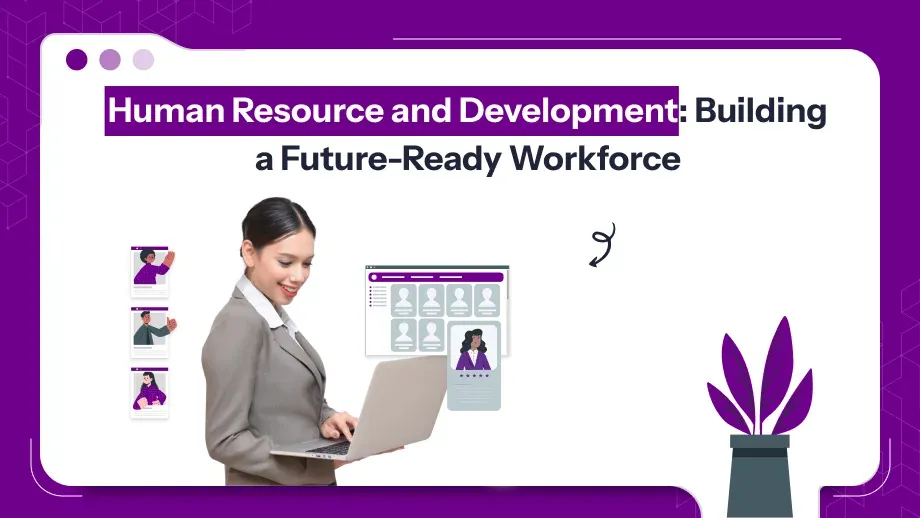
Introduction
Human Resource and Development (HRD) has a crucial role in the shaping of the workforce for every organization. In focusing on developing abilities, skills, and capabilities, HRD ensures employees remain well-equipped to meet the challenges ahead and achieve success. The modern business world views HRD as an important purpose that helps align employee satisfaction and organizational goals.
In this blog, we’ll look at the idea of development and human resources the importance of it, as well as ways to implement it successfully. From training in human resources and development to HR development management, we’ll be covering every important area.
What is Human Resource and Development?
Human Resource and Development refers to planned efforts designed to increase the knowledge as well as the overall performance of employees in an organization. This includes activities like the training of employee development plan and development of the organization. Through integrating human resource planning and development, businesses are able to align their workforce skills to business goals
Human Resource Development Concept
The main idea behind the company is to create the opportunity for employees to develop both personally and professionally. It focuses on formal education as well as experiential learning. It helps workers adapt to the changing demands of their demands of their jobs.
Core Components of HRD
Human Resource Training and Development
Training and development is an integral part of human resource and development. Training is focused on empowering employees with the abilities they require for the current job, whereas developing them prepares them for any future challenges or responsibilities. Some examples include:
- Technical Training: Develops specific job capabilities such as the use of software or the operation of machines.
- Leaders’ Training Programs: Trains future managers for leadership roles.
- Leadership Programs: Prepares potential leaders for managerial roles.
Regularly scheduled training and development programs increase employee productivity and ensure that individual abilities are aligned with the organizational objectives.
Career Development
The development of their careers allows employees to grow within their jobs and reach the professional goals they have set for themselves. This involves:
- Career Pathways: Mapping out possibilities for career paths within the company.
- Mentorship programs: Putting workers with experienced mentors to offer assistance.
- Skill-Building Workshops: Offering specific training sessions that help you develop specific skills.
Companies that invest in the development of their employees create a sense of long-term commitment and loyalty within their employees. Leveraging HRMS payroll software in India further streamlines this process by providing tools to track growth, manage performance, and support employee development seamlessly.
Organizational Development
The focus of organizational development is to improve the structure overall and effectiveness of an organization. It includes:
- Change Management: Guiding employees through organizational transformations.
- Team-Building: Activities for Strengthening Collaboration and synergy among groups.
- Process Improvements: streamlining the workflow to increase effectiveness.
This element ensures that the business stays competitive and agile in an ever-changing business climate.
Enhance Human Resource and Development with Automation!
Optimize efficiency by 30% through a tech-driven employee development plan. Streamline HR processes and focus on what matters most.
The Importance of HRD in Organizations
Human resource and development is a must in modern-day businesses. Here are its key benefits:
- Enhanced Employee Performance
Employees who undergo consistent training are better equipped to perform their roles effectively.
- Improved Employee Retention
Organizations investing in human resources and development tend to retain employees longer as they feel valued.
- Increased Adaptability
Through HR development management, companies can help employees adapt to changing technologies and market conditions.
- Better Organizational Culture
HRD fosters a positive work environment, encouraging collaboration and innovation.
Human Resource Planning and Development
The most effective human development and planning of resources involves predicting the future demands of an organization and then preparing employees for these demands. Key steps include:
- Workforce Analysis
Evaluate current employee skills and identify gaps.
- Training Initiatives
Introduce targeted programs to fill skill gaps.
- Succession Planning
Prepare employees for leadership roles to ensure organizational continuity.
Functions of Human Resource
HRD serves multiple functions of human resource development to drive organizational success:
- Talent Acquisition
Hiring the right talent is the foundation of HRD. A well-structured recruitment process ensures skill alignment with organizational needs.
- Employee Development Plans
These plans outline individualized training and career paths for employees, aligning their aspirations with company goals.
- Staff Development
Focused on staff development program and skill enhancement, these programs ensure employees remain competitive in their fields.
- Performance Management
Continuous feedback and evaluations help employees achieve their development goals while contributing to organizational objectives.
Challenges in Human Resource and Development
While human resource and development is important it also has its fair share of difficulties:
- Rapid Technological Advancements
To keep up with constantly changing technology is a constant process of learning and upgrading.
- Budget Constraints
Allocating resources for extensive training programs can be difficult for smaller organizations.
- Resistance to Change
Employees may resist new training methods or changes in their work processes.
- Measuring ROI
Quantifying the impact of HRD initiatives remains a significant hurdle.
The Role of Technology in HRD
Technology has transformed how organizations implement Human Resource and Development strategies, making processes more efficient and impactful. Here are three critical aspects:
E-Learning Platforms
The advent of e-learning has transformed employee training through the provision of flexible, easy methods of learning. The employees can gain access to training resources whenever they want and can study at their own pace. Interactive classrooms, virtual classes as well as gamification components increase the level of engagement and retention.
HR Software in India
Modern HR software streamlines various human resource and development activities, including training management, performance tracking, and employee development planning. These tools offer comprehensive solutions to monitor progress, schedule training sessions, and analyze outcomes effectively, ensuring a seamless integration of human resource and development initiatives.
Data Analytics
Advanced data analytics tools enable HR development goals managers to assess training effectiveness and identify skill gaps. By analyzing employee performance metrics, organizations can tailor their HRD programs to address specific needs, improving ROI and overall efficiency.
Developing Human Resources for the Future
The process of developing human resources is an ongoing and proactive procedure that helps organizations face future challenges and maximize potential. It involves:
Re-skilling and Upskilling As businesses evolve, companies need to provide their workers with current skills to stay in the game. Upskilling concentrates on improving existing skills as reskilling prepares workers for a completely new job. This includes training in the latest technology, making the most of digital tools and techniques, as well as understanding new methods of learning.
The development of leadership Skills is essential to the success of an organization. Programs for leadership development help employees to identify and develop their potential for leadership, and provide their minds with strategic thinking as well as decision-making and management capabilities. Through the development of an environment of competent leaders organizations can guarantee seamless transitions when leadership transitions.
Promoting Diversity and Inclusion A Broad and diverse workforce offers different perspectives, fostering the development of ideas and fostering creativity. HRD initiatives must actively encourage inclusiveness through fair recruitment practices and training in cultural awareness as well as equitable growth opportunities.
Making a Learning Culture Organizations That prioritize education and learning inspire employees to search for information continuously. It involves providing the option of educational platforms online, hosting seminars on sharing knowledge, as well as encouraging employees to take on certifications as well as higher education.
Building Agility and Flexibility for employees in the uncertainty of life is essential to achievement. HRD programs should concentrate on developing resilience, adaptability, and problem-solving abilities that allow employees to flourish within dynamic settings.
Steps to Build an Effective HRD Program
To create a highly effective HRD plan, businesses must:
- Conduct a Needs Assessment
Examine current capabilities and determine the future needs.
- Design Tailored Programs
Customize training programs to address specific organizational and employee needs.
- Implement and Monitor
Ensure consistent program delivery and monitor progress.
- Evaluate Outcomes
Use performance metrics to measure the program’s effectiveness.
Linking HRD to Business Goals
To allow HRD to make a significant impact, it has to be aligned strategically with the organization’s objectives. Here’s how organizations can tie HRD initiatives to reach the goals they set:
- The process of identifying Organizational Priorities HRD should start by gaining a thorough knowledge of the goals of the business. If it’s increasing customer satisfaction and productivity or expanding market access HRD initiatives must focus on these issues.
- The definition of the SMART (Specific measurability, achievable, and time-bound) targets ensures that HRD programs remain focused on the achievement of tangible results. In the example above, an implementation of the leadership program might have the goal of reducing the amount of employees who leave over a year.
- Tailoring Training to Business Needs Customized HRD programs ensure employees develop skills directly applicable to their roles. For example, sales teams may require negotiation training, while tech teams are focused on coding abilities.
- Integration of HRD and Performance Metrics Aligning human resource and development to KPIs, or Key Performance Indicators (KPIs) assists in evaluating the performance of training projects. Evaluations regularly ensure that programs are efficient and pertinent.
Conclusion
Development and human resource development are more than a mere function. It’s an essential element of every business that wants to achieve longevity. Focusing on human resource training and development, job management, as well as HR development management businesses, can create a strong and knowledgeable workforce. Integration of technology, for example, HR software in India, will further increase the effectiveness and efficiency of human resource and development initiatives.
Make the first investment into human resource and development now to tap into the capabilities of employees to be able to sustain growth. The journey toward success begins with developing human resources for the future.





